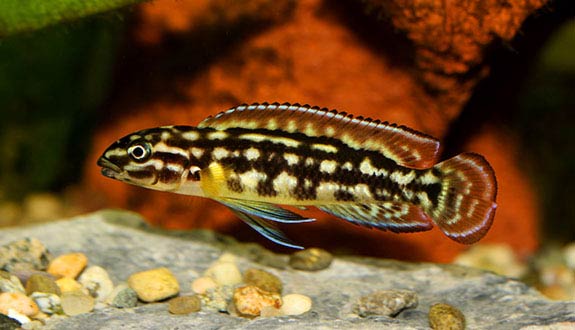

Alternative species (click on the thumbnail to see the card)
Names
Scientific name
Julidochromis marlieri
Common name
Marliers Julie
Marlier’s Julie
Schachbrett-Schlankcichlide (DE)
Origin

Origin: Africa (north west of Lake Tanganyika)
Biotope: African
Dimorphism
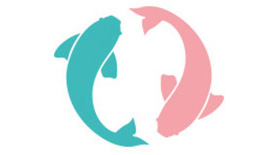
The genital papilla of the male is pointed and has a slight bump on the head
Group
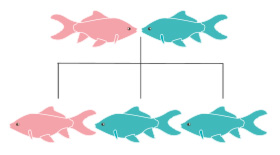
Cichlidae
Volume

120 L / 25 imp gal / 30 US gal
Parameters

T°: 24 à 27°C or 75 to 81°F
pH: 7.5to 8
Hardness: 5 to 20°dGH
Difficulty

Easy
Size

13 to 15 cm (5 to 6")
Longevity

7 to 9 years
Living zone
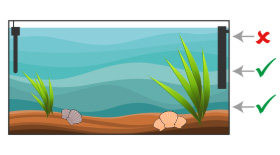
Middle and depth
Individuals

2
Food
How to feed the Marliers Julie?
Food
How to feed the Marliers Julie?
Naturally, this Julido is insectivorous. In captivity, most of its diet will be based on live or frozen prey. You can vary its food with dry foods like glitters that are easily accepted.
Behavior
What kind of behavior does the Marliers Julie have?
Behavior
What kind of behavior does the Marliers Julie have?
This fish is very interesting to watch. It evolves near the decor of your aquarium.
When they are young, you can form a group of 5 to 6 specimens. Growing up, a couple will form. The other fish will then be driven out of the territory.
If a couple is formed, they will like to stay near a cave that they will have chosen as a den. It is a monogamous fish.
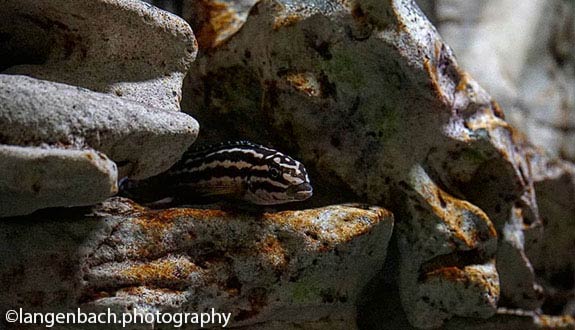
Cohabitation
Who can live with the Marliers Julie?
Cohabitation
Who can live with the Marliers Julie?
Most of the time, the Julido Marlieri is rather calm. However, it becomes aggressive and quite territorial during the breeding periods but also after, when the fry are born. In fact, parents protect their young from predators.
In general terms, given its territorial nature, this fish does not appreciate the presence of other territorial species.
If you want to keep other fish with him, plan an aquarium of at least 200 liters or 44 Imp Gal or 53 US Gal or more. Indeed, the more space there will be, and the less the tensions will be strong. You will avoid unnecessary conflicts. Ideally, choose fish from the same biotope (Lake Tanganyika).
Breeding
How to breed the Marliers Julie?
Breeding
How to breed the Marliers Julie?
Breeding can be successful without your intervention even in the main aquarium, because it is very discreet. In order to stimulate breeding, cavities, caves, hiding places must be provided in the decoration... The fry will remain hidden there for some time after their birth (observe these places regularly, you may have a surprise!).
Breeding can take place spontaneously just with a couple and some hiding places. A 100 liter or 22 Imp Gal or 26 US Gal aquarium is enough if you want to raise the fry apart. However, the community aquarium survival rate is quite high.
The brood can include up to 300 eggs and the incubation of fry takes about 72 hours. After birth, the fry remain close to the nesting site in the cavity. It is in the care of parents who jealously defends predators. The survival rate is pretty good.
Well-filtered and clean water is a plus for fry survival.
Fry food: artemia nauplii and zooplankton.
Its aquarium
Which aquarium for the Marliers Julie?
Its aquarium
Which aquarium for the Marliers Julie?
In its natural environment, this fish lives near rocks in deep water. The soil is sand. Reproduce these conditions in an aquarium by proposing a rocky setting on a sand bed (for the stability of your decoration, install your stones then sand. If the stones rest on the sand, the stability of the whole is not very good and there is a risk of landslide). The rocky setting should be deep enough to allow the formation of caves and hiding places essential to the well-being of this species (you can also propose inverted flower pots as hiding places).
Clean, well-oxygenated water is good for Julido Marlieri. For this purpose, plan for a sufficiently powerful filtration. Regular water changes will also be essential to maintain good water quality (25% of volume each week).
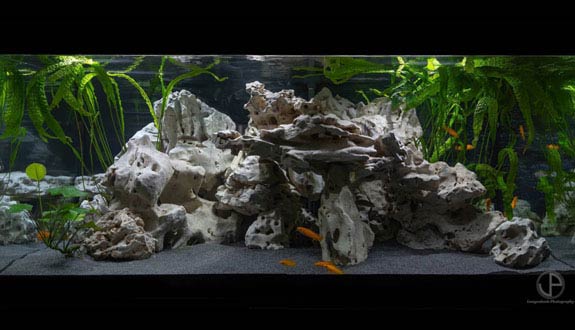
Good To know
Find all additional information!
Good To know
Find all additional information!
Never put other species of Julidochromis in your aquarium because there are risks of hybridization.
Yours photos!
Comments
Sort by:
Please login to post comments
